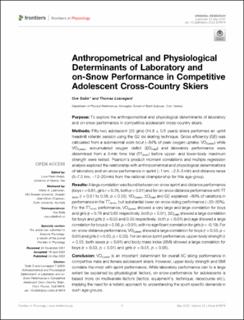| dc.description.abstract | Purpose: To explore the anthropometrical and physiological determinants of laboratory and on-snow performance in competitive adolescent cross-country skiers.
Methods: Fifty-two adolescent (25 girls) (14.8 ± 0.6 years) skiers performed an uphill treadmill rollerski session using the G2 ski skating technique. Gross efficiency (GE) was calculated from a submaximal work bout (∼84% of peak oxygen uptake; V̇O2peak) while V̇O2peak, accumulated oxygen deficit (ΣO2def) and laboratory performance were determined from a 3-min time trial (TT3min) before upper- and lower-body maximum strength were tested. Pearson’s product moment correlations and multiple regression analysis explored the relationship with anthropometrical and physiological determinations of laboratory and on-snow performance in sprint (∼1 km, ∼2.5–3 min) and distance races (5–7.5 km, ∼12–20 min) from the national championship for this age-group.
Results: A large correlation was found between on-snow sprint and distance performance (boys r = 0.61, girls r = 0.76, both p < 0.01) and for on-snow distance performance with TT 3min (r = 0.51 to 0.56, p < 0.05). V̇O2peak, ΣO2def and GE explained ∼80% of variations in performance in the TT3min, but substantial lower on-snow skiing performance (∼20–30%). For the TT3min performance, V̇O2peak showed a very large and large correlation for boys and girls (r = 0.76 and 0.65 respectively, both p < 0.01), ΣO2def showed a large correlation for boys and girls (r = 0.53 and 0.55 respectively, both p < 0.01) and age showed a large correlation for boys (r = 0.56, p < 0.01), with no significant correlation for girls (r = -0.19). For on-snow distance performance, V̇O2peak showed a large correlation for boys (r = 0.53, p < 0.01) and girls (r = 0.50, p < 0.05). For on-snow sprint performance, upper-body strength (r = 0.55, both sexes p < 0.01) and body mass index (BMI) showed a large correlation for boys (r = 0.53, p < 0.01) and girls (r = 0.51, p < 0.05).
Conclusion: V̇O2peak is an important determinant for overall XC skiing performance in competitive male and female adolescent skiers. However, upper-body strength and BMI correlate the most with sprint performance. While laboratory performance can to a large extent be explained by physiological factors, on-snow-performance for adolescents is based more on multivariate factors (tactics, equipment’s, technique, racecourse etc.), implying the need for a holistic approach to understanding the sport-specific demands in such age-groups. | en_US |
